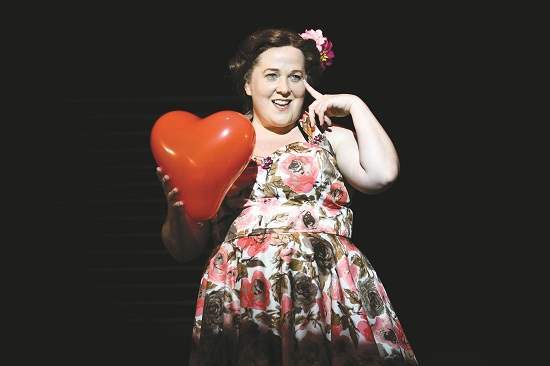NEW YORK, United States — Mary, a woman dressed as an old man.
Another Mary, a woman in a lobster suit. John Kane, a nervous mental patient in
blue pajamas. And a nameless drummer who never speaks. These eccentric
characters come together in Enda Walsh’s often baffling yet always arresting
new play, “Medicine,” a presentation of Landmark Productions and the
Galway International Arts Festival that opened at St. Ann’s Warehouse on Tuesday.
اضافة اعلان
John (
Domhnall Gleeson) wanders onto the set, a drab room
with the look of a community center hall (design by Jamie Vartan). It’s a mess
— the aftermath of a staff party, with streamers and balloons — and John is
concerned about it. He putters around, fidgeting and picking things up
haphazardly.
He’s preparing for the arrival of the two Marys (
Aoife Duffin and
Clare Barrett) and the drummer (Sean Carpio). They’re there at the
institution to run through a script of John’s life, presumably as a kind of
drama therapy.
Once they arrive and their routine gets underway, the Marys
don different costumes and lip sync a recording of dialogue from the people in
John’s life, beginning with his parents on the day he was born. As John narrates,
the Marys interrupt, to share notes and perform random dances while the drummer
scores the scenes. But as John’s story unfolds, he becomes increasingly
frazzled.
 (Photo: NYT)
(Photo: NYT)
Walsh, a celebrated playwright and director whose enigmatic
works include “Grief Is the Thing with Feathers,” “Arlington” and “Rooms,” also
writes and directs this play, which feels like a psychosexual absurdist
fantasy. How long has John been here? What parts of this are real? Walsh is
less concerned with providing answers than he is with making us sit with John’s
mounting sense of desolation and shame. In this way, the work resembles a poem
or an interpretive dance, resonating with symbols and gestures and feelings,
and the rest is for the audience to puzzle through.
John recounts abuse by his parents and peers when he was a
child, and maltreatment at the hands of a worker at the institution. He
scrutinizes his mother’s negligence and overt sexuality, and conflates his
budding erotic desires as a teen with his yearning for maternal love and
attention. All the while the narcissistic Lobster Mary (or Mary two, as the
script calls her) controls the performance: She harasses Mary one and bullies
John.
If that weren’t Freudian enough, Walsh plants recurring
images and themes throughout, implying connections between John’s version of
his past and the present moment with the actors.
What the two Marys are doing here is its own theater — a
production that Mary one starts to suspect is cruel. As they step into and out
of the personalities in John’s life, the lights shift with Earth, Wind and
Fire’s “September” playing. (Adam Silverman handles the mercurial lighting.)
Barrett gives a menacing performance as Mary two, who
embodies some of the more brutal characters in John’s tale and aims her own shots
of hostility at Mary one (Duffin, who appeared as Ophelia opposite Ruth Negga
in “Hamlet” at St. Ann’s Warehouse in 2020). Duffin’s Mary is empathetic, so
much so that she inhabits John’s story, and at some point the voice-over of a
character she’s playing overlaps with her voice as she speaks the same lines.
The language here — which Walsh writes with aureate poeticism, full of vivid
imagery and pointed symbolism — is what gives the show its melancholic beauty.
Then there’s Gleeson himself, with his impressive
performance. He is a chameleonic TV and film star (“
Harry Potter,” “
Star Wars,”
“
Run”) who can convey anything from a villainous sneer to a sensitive whimper
with his entire physical bearing. Despite his height, Gleeson seems to wilt
like a flower in want of sun. He nervously shuffles around the stage or gets
worked into a frenzy — huffing and flailing with explosive bravado, seamlessly
accompanied by Carpio’s percussion. (Helen Atkinson handily controls the
layered sound design.)
 (Photo: NYT)
(Photo: NYT)
There could easily be more Gleeson — and by that I mean more
of John’s perspective, because we get only snapshots of his life. By the end,
John reasserts that he’s “not like other people” and belongs in the
institution. It seems John is a victim of a kind of manipulation; the drama
therapy isn’t to help him but to gaslight him into believing he mustn’t ever
try to seek freedom. Beneath all the oddities of Walsh’s script is a criticism
of the ways in which society fails the mentally ill.
It’s unclear whether Walsh is also indicting theater — this
is, after all, a play in which a play is used toward devious ends. So perhaps
“Medicine” is simply a work of fanciful mysteries. Honestly, it doesn’t really
matter. The emotional core of the show is always prevalent.
By the end, John’s dejection feels as familiar as a phantom
pain. He may still be within the same sad four walls where he began, but
Walsh’s production transforms the space from one of isolation into one of
empathy that even the audience can share. Because ultimately, a couple of doses
of human connection is the best medicine anyone can ask for.
Read more Trending



